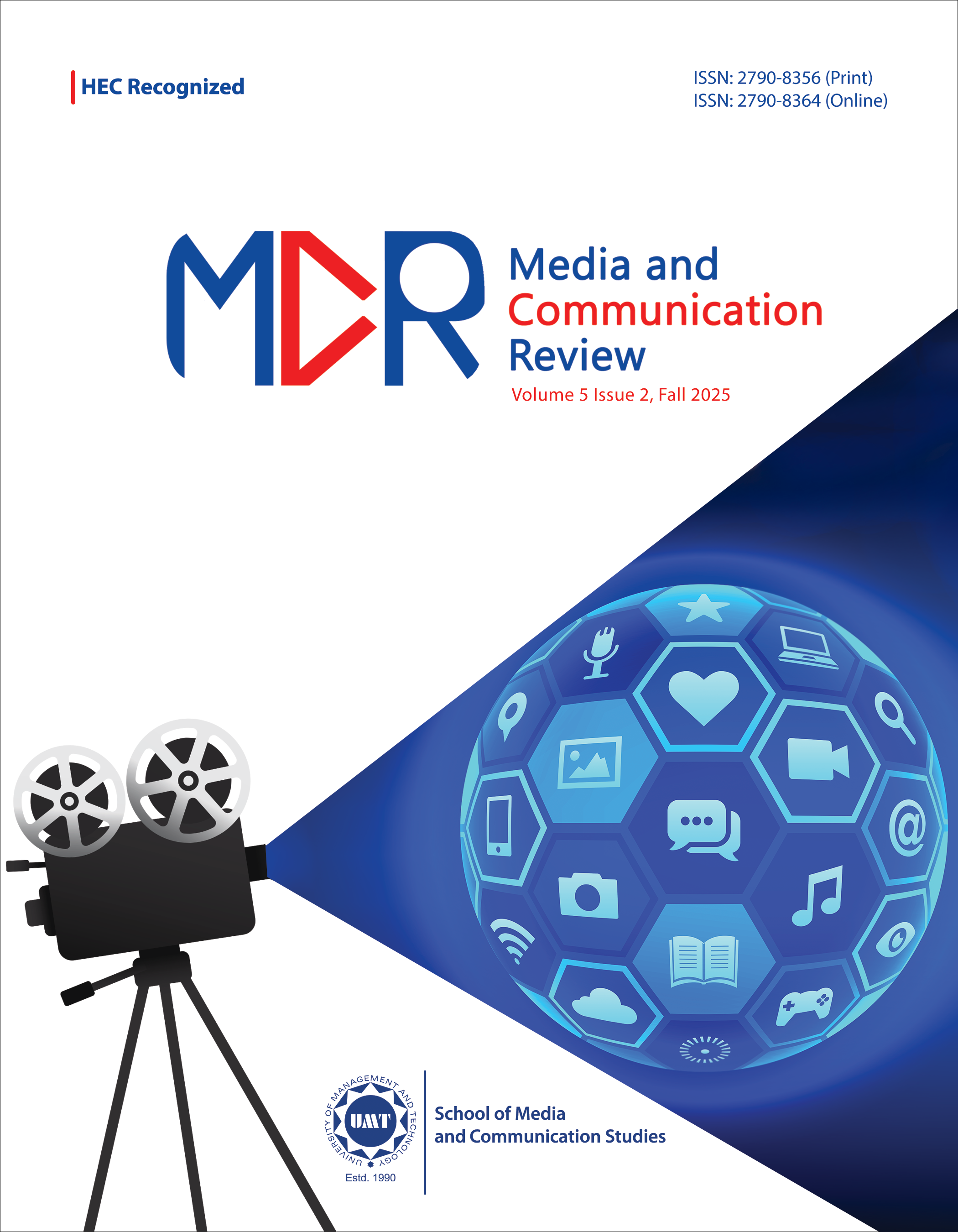Representations of AI in Pakistani Newspapers
Abstract
 Abstract Views: 0
Abstract Views: 0
This study has explored the representation of artificial intelligence in Pakistani newspapers. What perspectives and concerns they have shared about artificial intelligence? To understand the importance of AI: researchers checked the prevalence of AI in news coverage (ope-ed articles), categorical and temporal sentiment analysis, AI Framing: Risks and rewards regarding AI, AI coverage concerning Business, politics, law and order, education, military & intelligence, health care and others. The methodology of the study is quantitative and qualitative content analysis. The sample of the study is the columns from January 2023 to January 2024 of the three leading English dallies: Dawn, Pakistan Today, and The Nation among the top Ten English dallies using a purposive sampling technique. The reason for selecting the most recent articles is that the researcher wants to add the most recent information regarding AI to integrate the most recent findings. The findings show that Pakistani newspapers showed optimistic to cautious sentiments towards the use of artificial intelligence in our daily lives and the most prevalent frames are Risk and rewards of AI, the Role of AI in education followed by the role of AI in the legal system.
Downloads
References
Bryant, J., Zillmann, D., & Oliver, M. B. (2002). Media effects: Advances in theory and research. Routledge
Christodoulou, E., & Iordanou, K. (2021). Democracy under attack: Challenges of addressing ethical issues of AI and big data for more democratic digital media and societies. Frontiers in Political Science, 3, Article e682945. https://doi.org/10.3389/fpos.2021.682945
Chuan , C.-H., Tsai, W.-H. S., & Cho, S. Y. (2019, January 27–28). Framing artificial intelligence in American newspapers [Paper presentation]. Proceedings of the 2019 AAAI/ACM Conference on AI, Ethics, and Society, Honolulu, USA.
Chui, M., Manyika, J., & Miremadi, M. (2018, January 11). What AI can and can’t do (yet) for your buisness. McKinsey Quarterly. https://www.mckinsey.com/capabilities/quantumblack/our-insights/what-ai-can-and-cant-do-yet-for-your-business
Cools, H., Gorp, B. V., & Opgenhaffen, M. (2024). Where exactly between utopia and dystopia? A framing analysis of AI and automation in US newspapers. Journalism, 25(I), 3–21. https://doi.org/10.1177/14648849221122647
Dwivedi, Y. K., Sharma, A., Rana, N. P., Giannakis, M., Goel, P., & Dutot, V. (2023). Evolution of artificial intelligence research in technological forecasting and social change: Research topics, trends, and future directions. Technological Forecasting and Social Change, 192, Article e122579. https://doi.org/10.1016/j.techfore.2023.122579
Entman, R. M. (1993). Framing: Toward clarification of a fractured paradigm. Journal of Communication, 43(4), 51–58.
Eqbal, S. (2023, May 21). AI and the future. The Nation. https://www.nation.com.pk/21-May-2023/ai-and-the-future
Gamson, W. A. (1992). Talking politics . Cambridge University Press.
Gamson, W. A., & Modigliani, A. (1989). Media discourse and public opinion on nuclear power: A constructionist approach. American Journal of Sociology, 95(1), 1–37.
Goffman, E. (1974). Frame analysis: An essay on the organization of experience. American Psychological Association.
Gruetzemacher, R., & Whittlestone, J. (2022). The transformative potential of artificial intelligence. Futures, 135, Article e102884. https://doi.org/10.1016/j.futures.2021.102884
Kaack, L. H., Donti, P. L., Strubell, E., Kamiya, G., Creutzig, F., & Rolnick, D. (2022). Aligning artificial intelligence with climate change mitigation. Nature Climate Change, 12(6), 518–527. https://doi.org/10.1038/s41558-022-01377-7
Kane, T. B. (2019). Artificial intelligence in politics: Establishing ethics. IEEE Technology and Society Magazine, 38(1), 72–80. https://doi.org/10.1109/MTS.2019.2894474
Kelley, P. G., Yang, Y., Heldreth, C., Moessner, C., Sedley, A., Kramm, A., Newman, D. T., & Woodruff, A. (2021, May 19–21). Exciting, useful, worrying, futuristic: Public perception of artificial intelligence in 8 countries [Paper presentation]. Proceedings of the 2021 AAAI/ACM Conference on AI, Ethics, and Society, Virtual Event, USA.
Köstler, L., & Ossewaarde, R. (2020). The making of AI society: AI futures frames in German political and media discourses. AI & Society, 37, 249–263. https://doi.org/10.1007/s00146-021-01161-9
Mir, M. (2023, May 6). AI-3d-printing-and-non-proliferation. The Nation. www.nation.com: https://www.nation.com.pk/06-May-2023/ai-3d-printing-and-non-proliferation
Nader, K., Toprac, P., Scott, S., & Baker, S. (2024). Public understanding of artificial intelligence through entertainment media. AI & Society, 39(2), 713–726. https://doi.org/10.1007/s00146-022-01427-w
Nielsen, R. K. (2012). How newspapers began to blog: Recognizing the role of technologists in old media organizations’ development of new media technologies. Information, Communication & Society, 15(6), 959–978. https://doi.org/10.1080/1369118X.2012.694898
Njuguna, J. (2021). Constructions of moral values in reader comments of the Samantha sex robot discourse in East African newspapers. Journal of Religion, Media and Digital Culture, 10(3), 382–403.
Ouchchy, L., Coin, A., & Dubljević, V. (2020). AI in the headlines: The portrayal of the ethical issues of artificial intelligence in the media. AI & Society, 35, 927–936. https://doi.org/10.1007/s00146-020-00965-5
Reddy, S., Allan, S., Coghlan, S., & Cooper, P. (2020). A governance model for the application of AI in health care. Journal of the American Medical Informatics Association, 27(3), 491–497. https://doi.org/10.1093/jamia/ocz192
Rissland, E. L., Ashley, K. D., & Loui, R. P. (2003). AI and Law: A fruitful synergy. Artificial Intelligence, 150(1–2), 1–15. https://doi.org/10.1016/S0004-3702(03)00122-X
Said, N., Potinteu, A. E., Brich, I., Buder, J., Schumm, H., & Huff, M. (2023). An artificial intelligence perspective: How knowledge and confidence shape risk and benefit perception. Computers in Human Behavior, 149, Article e107855. https://doi.org/10.1016/j.chb.2023.107855
Sarısakaloğlu, A. (2021). Framing discourses in Turkish news coverage regarding artificial intelligence technologies’ prospects and challenges. Turkish Review of Communication Studies, 37, 20–38. https://doi.org/10.17829/turcom.803338
Sun, S., Zhai, Y., Shen, B., & Chen, Y. (2020). Newspaper coverage of artificial intelligence: A perspective of emerging technologies. Telematics and Informatics, 53, Article e101433. https://doi.org/10.1016/j.tele.2020.101433
Wang, W., Downey, J., & Yang, F. (2023). AI anxiety? Comparing the sociotechnical imaginaries of artificial intelligence in UK, Chinese and Indian newspapers. Global Media and China. Advance online publication. https://doi.org/10.1177/20594364231196547
Weiss, D., & Nemeczek, F. (2022). A media-based innovation indicator: examining declining technological innovation systems. Environmental Innovation and Societal Transitions, 43, 289–319. https://doi.org/10.1016/j.eist.2022.04.001
Zhai, X., Chu, X., Chai, C. S., Jong, M. S. Y., Istenic, A., Spector, M., Liu, J., Yuan, J., & Li, Y. (2021). A review of artificial intelligence (AI) in education from 2010 to 2020. Complexity, 2021(1), Article e8812542. https://doi.org/10.1155/2021/8812542
Copyright (c) 2025 Sadia Abbas, Ayesha Ashfaq

This work is licensed under a Creative Commons Attribution 4.0 International License.
Copyrights © Author(s) 2021




